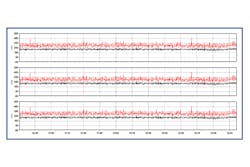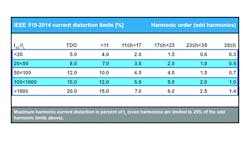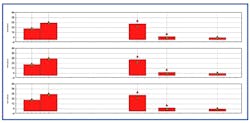Frequency inverters are increasingly installed for AC motor control on pumps, HVAC systems, conveyors and machine tools. Their ability to provide adjustable speed control with a standard NEMA B design squirrel cage motor has increased their use.
In the quest for ultra-compact, efficient power conversion, inverter manufacturers employ high-speed semi-conductor switching and pulse width modulation (PWM) techniques, which can create harmonic problems. In general, harmonic currents are the result of the non-linear behavior of electrical devices. The sources of harmonic currents and the subsequent harmonic voltage in power systems are multiple and vary in size, ranging from a few kilo-volt amps (kVA) up to several mega-volt amps (MVA).
Devices with magnetic iron cores such as transformers or generators have been a key area of harmonic concern, as are arc furnaces and welders. With today’s demands for energy efficient power electronic equipment, such as uninterruptible power supplies and variable frequency drives (VFD), reducing harmonics is a priority for many industrial users, and those in oil and gas and water and wastewater industries.
Active harmonic filters (AHF) are power quality devices that monitor a nonlinear load and dynamically provide precisely controlled current, helping prevent distortion in a power network.
Harmonics & equipment
The electronic components within computer numerical control machines, VFDs and programmable controllers are particularly sensitive to electrical imperfections found on the power distribution system. Problems here can include the malfunction of the equipment or program, along with damage of the parts and material.
For example, arc furnaces are usually a very large power consuming application. This high power combined with a highly nonlinear voltage-current characteristic produces substantial amounts of harmonic distortion. The unique design leads to an unusual harmonic spectrum with even and odd multiples of the fundamental frequency.
VFDs for pumps and fans can produce current harmonics that may cause thermal overload of the electrical systems and produce malfunctions of sensitive equipment and components.
Most of the power problems experienced at the facility level are derived from within the operation of a plant itself because the majority of electrical power supplied to the user comes from an electric utility source or provider.
Harmonics can bring havoc to the electrical power network, and the resulting issues range from a simple nuisance to catastrophic loss. Harmonics can manifest themselves in many ways, causing tripped circuit breakers, blown fuses, overheating of motors and transformers, insulation break-down, or reduced service life of equipment. Even a simple nuisance can have negative effects. Production downtime/restart-time and shipment (revenue) loss along with repair costs may result in reduced company profits. Harmonic filtering helps eliminate the problematic harmonics, enhance efficiency and improve overall plant performance.
Harmonic data collection & IEEE 519
For any given site, a harmonic site survey of the use of power meters/analyzers or a full engineering study may be necessary to determine existing harmonics and other power quality issues as a means to a recommended solution. A complete review of the existing system, including retrofitted and planned equipment, along with any plant expansions, should be considered. In many cases, IEEE-519-2014 guidelines are followed as to the acceptable level of distortion.
IEEE-519-2014 is a widely recognized set of recommendations that includes the maximum permissible current and voltage distortion values at the point of common coupling (PCC). The distortion limit is given as a function of the system loading, such as the relationship between the maximum short circuit current (ISC) and the maximum demand load current at the PCC.
After harmonics are identified and it has been determined that a mitigation solution is required, proper equipment selection will need to be reviewed and implemented. Many problems are associated with harmonics including equipment failure, replacement and maintenance costs, improper component or system operation, and production down time. Considering this, it is suggested to keep records on these costs to have real data for comparison when it comes time to calculate the projected return on investment for any future mitigation equipment purchase.
Figure 1. (Top) IEEE-519-2014 is a widely recognized set of recommendations that includes the maximum permissible current and voltage distortion values at the point of common coupling.
Site survey example
Consider the example of a power-quality site survey and equipment recommendation. The user wanted to determine harmonic current-levels on two specific power drops, 480 VAC and 60 Hertz. A power-drop consists of three individual single-phase transformers, 12.47 kilovolts (kV) and 480 VAC, delta connected to a secondary. This site has numerous power drops and differing harmonic load-levels, due to the total number and horsepower rating of each installed VFD.
At present, the total electrical load is 35 MVA. The majority of the 480 VAC loads are VFDs. Harmonic loading of the main utility-supply is a concern. The two power-drops investigated were the two most heavily loaded. The total horse-power rating of VFDs exceeded the kVA rating of the supply-transformers by nearly 100 percent. However, this is acceptable because the actual loading of the VFDs rarely exceeds 50 percent.
Potential thermal overload due to harmonic current-levels of the supply-transformers, both at the individual power-drops and at the two main substations, was the main concern. In order to substantially reduce the harmonic loading of this power distribution-system, filtering must be a high priority.
The site survey measurements on power-drops were performed using a power analyzer. The transformers were rated at 166 kVA per phase with an impedance of 2.7 percent.
Survey results
Figure 2 shows a three-hour time line of average and maximum line-current at this power-drop with average currents of 220 amps (A) and occasional peaks of 350 A. An instantaneous reading of power and power-factor gave 169 kW, 190 kVA and 0.89 power factor.
Figure 3. Oscilloscope picture of line-voltage and line-current
Figure 3 shows an oscilloscope-picture of the momentary phase-to-phase voltage and phase-current on this power-drop.
Figure 4 shows the harmonic current-distortion. The total harmonic current distortion (THDi) is approximately 30 percent, and the dominant harmonic is the fifth order harmonic.
The monitoring performed indicated the existing load picture showed an average of 66 A of harmonic compensation current would be required. The second power drop indicated very similar readings.
With the number of power drops, varying loads and low power factor involved, an active harmonic filter was recommended. The 66-A value is well within the capabilities of a 100-A active filter. The filter capacity will also allow for a significant amount of higher momentary loads like what was recorded. Unused filter capacity could be utilized to raise the power factor on this power-drop. The actual filter configuration may use individual units, or one integrated system to potentially accommodate multiple drops.
Figure 4. Harmonic current distortion
Additional monitoring will need to be performed for the other power drops to confirm similar conditions. Once completed, a final equipment recommendation and design configuration can be provided. A 100-A active harmonic filter for each connection would be properly sized to compensate the harmonic currents present on these two most heavily loaded power drops.
Active harmonic filter solution
AHFs permanently monitor the nonlinear load and dynamically provide precisely controlled current, helping prevent distortion in a power network. This current has the same amplitude of the harmonic current but is injected in the opposite phase-shift, canceling out the harmonic currents in the electrical system. As a result, the current supplied by the power source will remain sinusoidal because the harmonics will negate each other and the harmonic distortion is reduced to less than 5 percent THDi, meeting all standards.
Additionally, the AHF power electronics platform is designed to operate at levels that continuously adapt to rapid load variations. With load conditions creating harmonics up to the 50th order, active filters operate in a wide frequency range, adapting their operation to the resultant harmonic spectrum.
AHFs can also correct poor displacement power factors by compensating for the system’s reactive current. The filter performs load balancing of the phases. Presently, these higher sophisticated devices are equipped with insulated gate bipolar transistors and digital signal processing components. Generally, active harmonic filters can be installed at any point in a low voltage AC network (parallel device), and they usually offer more functionality than their passive filter counterparts.
Combining these features with its small physical size and efficient operation, active harmonic filters work well for a variety of applications. Active filters can be provided for 3-wire or 4-wire connections; 3-wire is the most common in North America. The use of external current transformers delivers a signal to the filter, which can be applied to either the line or load side of the power network.
Active harmonics filters can be applied to a single or group of nonlinear loads. Other possible AHF installations can occur when power factor correction in harmonic rich environments cannot be suitably achieved by the use of capacitors; where both power factor and harmonic correction are required; and where emergency power or distributed generation are present in the electrical network.
In general, active harmonic filters are available in several ratings. These include individual units for 50, 100, 200, 250 or 300 A. Configurations such as open type, or various NEMA enclosure protection ratings and the ability to parallel multiple active filters for higher current applications are typical. A standard integrated package to 400 A can be provided for either indoor or outdoor use.
Installation voltages are mostly 480 VAC and 600 VAC. Additionally, those that require 600 VAC can utilize a step-down 600/480 VAC transformer with the active harmonic filter, or they can use a purpose built active filter rated for 600/690 VAC, where a transformer is not
necessary. Active filters will include key pad controls and operator display communications such as RS485 and TCP/IP Ethernet, along with software for communications and monitoring through a Windows-based product.
Where machinery, equipment and processes are electronically controlled and need to meet exacting operational standards, sensitive electronic components also need to be protected from the harmonics driven by the facility’s electrical power distribution system. Using active harmonic filters can help achieve the proper operation and reliability while helping to support the financial bottom line.
Editor’s Note: The authors would like to acknowledge the following: IEEE Std. 519 Recommended Practice and Requirements for Harmonic Control in Electrical Power Systems 2014; IEEE Std. IEEE Recommended Practice for Monitoring Electric Power Quality; IEEE Std. 1531 IEEE Guide for Application and Specification of Harmonic Filters; IEEE Power and Energy Society; and the IEEE Transmission and Distribution Committee.
Chuck Gougler is the director of power quality for North America for Schaffner, and Claus Weigand is an application engineering manager for power quality. The Schaffner Group develops and produces efficient and reliable electronic systems.





